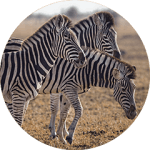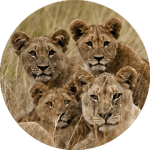Tanzania, a country where nature is in its rawest and purest form. Home of Africa’s greatest wonders. The big five, the great migration on the plains of the Serengeti and the animal-packed Ngorongoro Crater. Together they lie in the shadows of Africa’s highest mountain, Mount Kilimanjaro. Its impressive snowy peaks and breathtaking views watch over the millions of wild animals and broad variety of landscapes. Next to that lie its islands with pearly white, tropical beaches, turquoise ocean and blooming underwaterlife. A place where everyone can find their inner peace.
Tanzania is the largest country in East Africa. It is bordered by Kenya and Uganda to the north; Rwanda, Burundi, Congo to the west, and Zambia, Malawi, and Mozambique to the south. On the right of Tanzania, you’ll find the Indian Ocean.
Tanzania has more than 57 million inhabitants and is home to more than 120 different tribes. The country is one of the oldest known continuously inhabited areas on earth, with fossil remains of human(like) been found dating back to two million years ago.
Tanzania knows two official languages, English & Swahili. Next to those languages there’s numerous languages spoken only by certain tribes. There are more than 120 different tribes in Tanzania, many of those tribes have their own language. The local currency is the Tanzanian Shilling (TZH), but Dollars are often accepted in tourism destinations. People drive on the left side of the road. Mind that only the main roads are asphalt. The rest is off-road and badly or not maintained at all, driving in a 4×4 is advised.
Safari in Tanzania has been around for ages. Safari is another word for ‘journey’, but is often associated with spotting wildlife. It started with the first pioneers who set foot upon these lands. They had to encounter the big 5, face to face. Can you imagine! Now this seems like something of the past, but for several tribes in Tanzania this is still a thing. This makes for interesting stories.
For travellers however, safari is done is 4×4 vehicles and by visiting lodges or campsites to spend the night. At certain parks, walking safari’s are permitted under guidance of an armed ranger.
Within the parks, wildlife flourishes and animals roam free. There are no gates or paved roads, so animals migrate freely between the parks and the safari experience is as real and adventurous as possible. So even outside of the parks you might encounter wild animals. These parks host some of nature’s wonders like the great migration and the Ngorongoro crater, famous from many television channels like national geographic, animal planet or show’s like planet earth.
Because of this (and many other reasons), Tanzania is often considered the best country to make safari. Voted multiple times as ‘the best country to go on safari’ 1,000 safari tourists and 756 experts, including guidebook authors from Lonely Planet, Rough Guides, Frommer’s, Bradt and Footprint, over two years.
Safari is definitely Tanzania’s most popular highlight. Being able to spot the Big 5, having the earth tremble underneet your feet by millions of migrating wildebeest and being able to see a caldera with a unique habitat, supporting the world’s most dense population of animals certainly helps with Tanzania’s reputation.
These, among others are actually part of Africa’s 7 great wonders. To sum them up real quick, these are; The great migration, the Ngorongoro Crater and Mt. Kilimanjaro (Africa’s highest mountain at 5895m tall).
In Kilimanjaro’s long shadow, live over a 120 indiginous tribes, with many unique cultures and wholesome traditions. Spending a night with the maasai, living a day in their lives or hunting with the Hadzabe tribe, a tribe that still lives like in the stone-age are surely activities you’ll never forget.
Visiting Zanzibar is certainly also on the Tanzania highlight list as it’s the perfect ‘tropical paradise’. Neverending white-sand beaches, palmtrees everywhere and turquoise blue waters with rich ocean-life surely puts it at the top of many people’s bucketlists.
Tanzania’s lands are filled with amazing places like oasis, jungles, deserts, rainforests, waterfalls, mountains. This makes it perfect for numerous adventures like mountainbiking, climbing, hiking or adventurous motorcrossing! Everything is possible. Most of the land is raw & untouched nature, ready to be explored! The great thing about this country is that it’s fortunate enough to have both tourist destinations and destinations where no tourist has ever set foot.
The Tanzania National Parks Authority commonly known as TANAPA is responsible for the management of its national parks. TANAPA manages over 17 national parks, covering 15% of the country’s lands (57,024 km2).
Many of the safari-parks in Tanzania have been protected & preserved since the 60’s, making them truly unique in this world. Next to the national parks there’s protected wildlife management area’s, conservation area’s, game reserves etc.
The most famous ‘national parks’ are those of the northern circuit. All accessable from safari-capital Arusha:
Other popular ‘national parks’ are:
The UNESCO (United Nations Educational, Scientific and Cultural Organization) World Heritage Sites are places of importance to cultural or natural heritage as described in the UNESCO World Heritage Convention. Tanzania has seven UNESCO World Heritage Sites.
These are Serengeti national park (home to millions of wildebeest that form one of the world’s most spectacular sights as they migrate the area year-round), Ngorongoro conservation Area, Mt. Kilimanjaro (Africa’s highest mountain), Kondoa rock-art site, stone town (Zanzibar), Selous game reserve and the ruins of Kilwa & Songo Mnara.
Tanzania is rich in wildlife due to its huge, varied landscapes. From desert-like savannah’s to thick, wet rainforests. This country has it all. Since such a huge part of the country is uninhabited and/or protected, it is one of the last places on earth where wildlife can truly flourish. But even here some numbers decline and some animals are on the edge of extinction.
Throughout the country there’s a huge variety of animals to spot. Some are bound to certain area’s and can’t be spotten elsewhere. So make sure to do a bit of research on the animals present in a national park if you’re really interested in seeing certain types of animals.
We made a list of the ‘most wanted’ animals and their presence in Tanzania:
Abundant: Elephant, Giraffe, Hippo, Buffalo, Zebra, Wildebeest
Common: Lion, Hyena
Occasional: Leopard, Cheetah, Jackal
Rare: Black Rhino, wild dog
Next to these most ‘most wanted’ animals there are many other animals like a variety of gazelle’s, dikdik, anteaters, topi, eland, crocodiles, sable and many more smaller mammals. Primates like baboons, velvet monkeys, chimpanzees and even the endangered colobus monkey can also be found in Tanzania. Chimpanzees are only found in western-region, so seeing these is an expedition on its own.
Tanzania is one of Africa’s best birding destinations. It has one of the largest species lists of any African country; over 1,100 different species. The country has 22 endemic species and a 43 near-endemic, only visiting Tanzania and neighbouring countries while migrating. Birds that are commonly found are: lesser & greater flamingo, ashy starling, black crake, fisher’s lovebird, hartlaub’s turaco and the red- and-yellow barbet.
Tanzania is located in east-africa, bordering the Indian Ocean. Within the area there are quite a few islands that are part of Tanzania. Most of these island are easily reachable by direct flight from the main land or by boat from its most popular trocal holiday destination: Zanzibar.
Zanzibar – Tanzania’s favorite tourist destination and a perfect mix between ‘touristy’, but also loads of empty places. Pearly white beaches, turqouse waters and palm trees waving in the wind. A real dream location.
Other popular islands that are surely worth visiting are;
Chumbe island, Tanzania – A reserve with a coral reef sanctuary and forest reserve that harbour rare wildlife. On the island is a private eco-resort, featuring only 7 bungalows. Here you can snorkle in East Africa’s most diverse coral reef, get guided walks through the forest trails and inter-tidal area’s and spot the endangered coconut crabs.
Mafia island, Tanzania – A more ‘off the beaten track’ and quiet island. Especially popular for divers and famous for the whalesharks that pass here every year, giving you a chance to swim with one of the ocean’s biggest and most interesting creatures.
Pemba island, Tanzania – The smaller sister of Zanzibar and with few visitors. There’s a few lodges on the island and the infrastructure is underdeveloped. Making het island wilder and more exclusive. Just like the other islands, it’s perfect for water-activities like diving & snorkling.
Tanzania is home to over 120 indiginous tribes, all with their own unique cultures and traditions. Some of the most famous tribes are the Maasai tribe with their colorfull clothing and the Hadzabe and their ‘hunter & gatherer’ style ways of life.
Other known tribes are:
Tanzania is a country with a very rich and versatile culture. Its culture is Swahili, an Arab/African mix. It has has been colonized by several countries, ‘resulting in arabic, english and german influences among other countries. Stone town (Zanzibar), is a good example of how the arabic culture left its stamp on Tanzania.
In Tanzania there are also big Asian communities, particularly Indian, in towns and cities. Outside of the cities there are numerous tribes (over 120), all with their own cultures, traditions and beliefs.
The people of Tanzania are considered to be very friendly and helpful people. Everything is ‘hakuna matata’ and ‘pole pole’, meaning ‘no worries’ and ‘slowly slowly’.
Tipping is expected in Tanzania. Not only for your guides & cooks on safari, but also waiters in restaurants & hotel-employees. The size of the tip depends on the size of their service.
Saying hello and asking how they are, is a must before starting any conversation. Tanzanians are big on shaking hands, small talk and involving you in their lives. You could end up being invited to their families wedding after having just met. Making twenty phone calls a day to stay in touch with their families and friends is part of that. Having a Tanzanian friend, expect a text or call every other week just to ask how you are. This might seem a bit strange, but we’ve gotten used to it.
The biggest religion in Tanzania is christianity, more than half of the population identifies as christian. There’s also quite a few muslims in Tanzania. Within the (120+) tribes, many people practice their own folk religion or have their own adaptation of christianity.
Tanzania has a pleasant, tropical climate, but has large regional climatic variations influenced by several factors, including altitude.
The northern part of Tanzania knows warm days and cool evenings, meaning you can sleep nicely under a blacket without the airconditioning on. Humidity is usually quite pleasant, but varies due to altitude- and season changes. There’s no real winter or summer, just a distinct wet & dry season. Arusha is the town closest to the most popular northern parks and has a comparably mild climate.
June-October – Temperatures are usually between 20°C-35°C/, but can vary greatly according to altitude and location. In Arusha it’s mildly warm during the day with cool evenings. When you’re going on safari (south-wards) day-temperatures can rise quickly.
March-May – These are the wettest months. Also called the big rain season. It tends to rain heavily almost every day, usually short, heavy downfalls at the beginning and end of the day.
November & December – The short rains. A period of about a month of short rains which occurs sometime between November and December. Its timing is unpredictable and, in Northern Tanzania, it can even happen in October. The rains will rarely interfere with your safari.
January & February – The northern parks and coastal areas tend to have a break in the rainy season and is often a popular period to visit the country. The other parks don’t really experience a dry spell.
Dar Es Salaam is Tanzania’s biggest city and former capital city. Dar Es Salaam is located on the coast and has a population of more than six million, which makes it Africa’s fifth largest city. The city’s name in Arabic means “Abode of Peace”.
Dodoma is Tanzania’s official capital since 1973. With a population of only 187.000, Dodoma is a much smaller city than Dar Es Salaam. The city has been chosen capital, due to its more central location.
Arusha is the central safari point in Tanzania and often considered ‘safari capital of the world’. It’s located close to the northern and most popular safari circuit. From Arusha you can easily visit Mt. Kilimanjaro or some of the country’s other highlights like the great migration or Ngorongoro crater.
Moshi is a beautiful city at the foot of Mt. Kilimanjaro and capital of the Kilimanjaro region. A more relaxed town than the busy city of Arusha. Moshi is often used as the base point before/after climbing Kilimanjaro. Both Arusha and Moshi are close to the International Airport in the Kilimanjaro Region.

1. REQUEST A TAILOR-MADE SAFARI

2. CALL WITH US ABOUT YOUR TRAVEL PLANS

3. CO-CREATE YOUR DREAMSAFARI

4. PACK YOUR STUFF, SAFARI NJEMA!